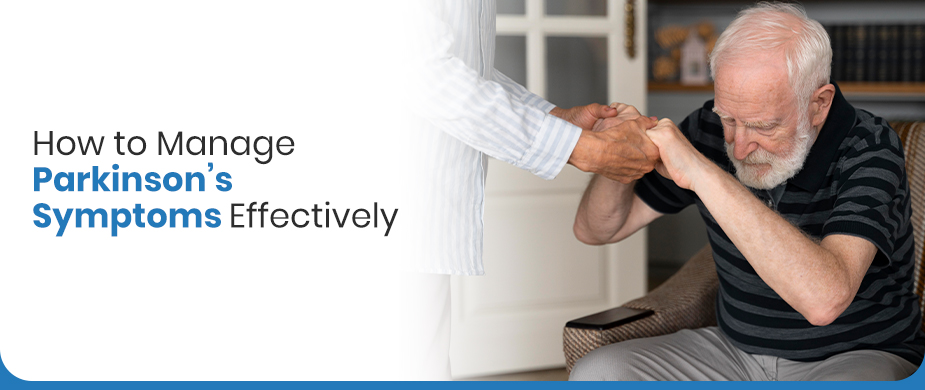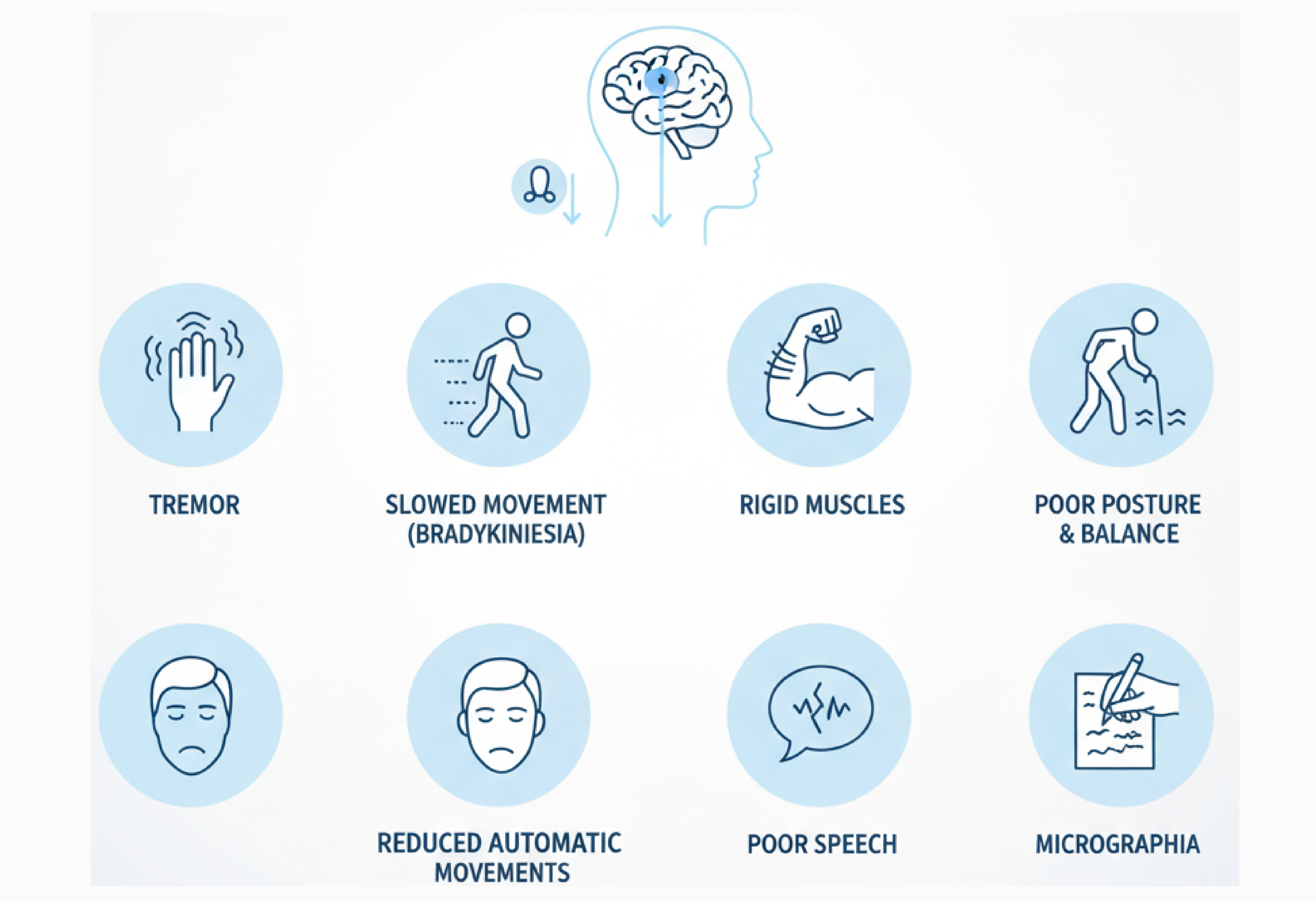
Book an Appointment
Call Us01140846835How to Manage Parkinson’s Symptoms Effectively
What is Parkinson’s Disease
Parkinson’s disease is a brain condition. This involves abnormality in the movement of your body parts. It occurs when some nerve cells in your brain stop working efficiently and/or die.
These nerve cells, present in the substantia nigra (a part of the basal ganglia), produce a chemical known as dopamine. This chemical is responsible for controlling movement and coordination. When these nerves get damaged or die, there isn’t enough dopamine, and you may notice symptoms such as shaking (tremors), stiffness, slow movements, or trouble with balance.
Health Note: If you notice frequent shaking, slow movements, or trouble balancing, it’s essential to seek medical advice from a licensed healthcare professional. This article provides general information to help you understand Parkinson’s disease and possible treatment options.

Why Parkinson’s Disease Happens
The exact reason behind this brain nerve cell damage is yet to be discovered; however, age, genetics, and environmental factors may play a role. Parkinson’s develops slowly, and while it can’t be completely cured, there are ways and medications to manage it effectively.
Knowing how Parkinson's disease symptoms are the first step toward managing it confidently and living life on your own terms.
Read this blog to know Parkinson's disease symptoms, treatment options, and ways to manage it.
Note: It is crucial to consult a licensed healthcare professional if you have any symptoms regarding Parkinson's disease. An accurate diagnosis and treatment will be conducted by them only.
How Does It Affect the Body: Common Parkinson's Disease Symptoms
The symptoms of Parkinson's disease may vary based on the severity and stage:
1. Tremor
This is known as a pill-rolling tremor, a rhythmic shaking that generally begins in your hands or fingers.
Why tremor may happen
Low dopamine level disrupts smooth muscle functioning, leading to unwanted shaking while resting.
2. Slowed Movement (Bradykinesia)
Bradykinesia means your simple movements become harder and slower.
Why bradykinesia may happen
The dopamine loss in the basal ganglia leads to inadequate coordinated muscle actions.
3. Rigid Muscles
Muscles may feel stiff, tense, and painful.
Why rigidity in muscle may happen
Deficiency of dopamine keeps muscles over-contracted, reducing flexibility.
4. Poor Posture and Improper Balance
Your posture may become stooped and lose stability.
Why poor posture and imbalance may happen
Damage to dopamine affects your body’s posture and balance control systems.
5. Automatic Movements Get Compromised
Blinking, smiling, or arm-swinging takes greater effort.
Why damage to automatic movements may happen
Damaged dopamine nerves disturb subconscious motor activity such as blinking, smiling, or swinging your arms when you walk.
6. Poor Speech
Your speech may be flat or monotone.
Why poor speech may happen
Lower levels of dopamine disturb the timing and coordination between muscles of the face, voice box, and tongue.
7. Micrographia (Handwritings Becomes Small & Cramped)
Handwriting may shrink and become cramped.
Why micrographia may happen
Basal ganglia damage causes bradykinesia (slowness of movement) and muscle rigidity, affecting pen control.
There is no treatment for Parkinson's disease, but proper medication, lifestyle changes, and rehabilitation programs can help lower its symptoms.
Diagnosis of Parkinson's Disease
A healthcare professional at the IBS hospital may run some tests to diagnose Parkinson's disease.
- Physical and neurological exam
- Blood and lab tests
- Imaging tests, like an MRI, a brain ultrasound, and a PET scan
- Genetic testing
- Alpha-synuclein test
- A short, low-dose treatment of medicines
Management of Parkinson's Disease Symptoms: Medication & Rehabilitation at IBS
Follow your doctor’s Parkinson's disease symptom management plan, which may include some medicines, lifestyle changes, and rehabilitation techniques.
These treatments aim to restore the level and function of dopamine, reducing the severity of symptoms.
A. Parkinson's Disease Treatment (Medicine) Options
Commonly prescribed Parkinson's disease medicines are:
- Levodopa and carbidopa: Help lower the symptoms such as slow movements and stiff, rigid body portions.
- Dopamine agonists such as pramipexole: These drugs mimic the action of dopamine in the brain for the proper body function.
- Anticholinergics such as benztropine: Help restore dopamine levels to reduce tremor frequency and muscle stiffness.
- Mao-B inhibitors like safinamide: They block the brain chemicals that damage dopamine so that its level can be increased.
- COMT inhibitors such as entacapone: They increase the effectiveness of levodopa.
B. Parkinson's Disease Rehabilitation
There are many rehabilitation techniques focused on easing the Parkinson’s disease symptoms. Some of the multidisciplinary approaches are:
- Virtual Reality (VR) and Exergaming: Improve movement and balance.
- Robot-Assisted and Passive Training: Retrain brain-muscle pathways.
- Telerehabilitation: Delivers customized therapy remotely.
- Non-invasive Brain Stimulation: Uses gentle electrical or magnetic pulses to boost dopamine circuits.
- Expiratory Muscle and Speech Therapy (LSVT): Strengthens breathing and voice muscles and helps improve speech clarity.
- Speech-Language Pathology: Help reduce voice and swallowing difficulties.
C. Lifestyle Changes to Prevent Parkinson's Disease
These lifestyle changes help you become more independent in life and ease Parkinson’s symptoms.
- Regular Exercise: Supports muscle and brain health.
- Balanced Diet: Maintains crucial body chemicals and overall wellness
- Good Sleep: Boosts body repair and recovery.
- Stay Socially Connected: Keeps your brain active.
- Use Safety & Home Modifications: Lowers the risks of falls and injuries.
- Keep in Touch With Your Hoppies: Keeps your mind and body connected.
- Follow Your Medication: Helps manage symptoms effectively.
- Seek Therapy (Physical, Occupational & Speech): Improves mobility and independence in your everyday tasks.
- Practice Mindfulness & Relaxation: Manages anxiety and stress.
Parkinson's Disease Rehabilitation | IBS Hospital
It's not the health challenges that slow your daily life; it's the lack of management that makes it worse. The treatment of Parkinson's disease is not there, but with the right guidance under an expert at the IBS hospital, help manage the symptoms properly. All you need to do is follow our customized rehabilitation process and adopt the lifestyle changes to attain independence.
How does treatment at IBS differ from conventional treatment
Walk Again, part of the IBS hospital, has the following modalities and techniques:
- Cyberdyne Hybrid Assistive Limb (HAL)
- Non-invasive sensors
- The Pablo system
- Tymo, a versatile rehabilitation
- Luna EMG technology
They differ from conventional methods in the following ways:
- Uses robotic exoskeletons to support patient movements.
- Real-time monitoring of muscle activity.
- Data-driven customization of Parkinson's rehabilitation.
- Promote neuroplasticity and functional recovery to restore walking and motor control.
- Tech-integrated personalized approach.
Explore the recovery and rehabilitation journey for our patients.
About IBS Hospital
This article was prepared by the IBS Hospital Neurology and Rehabilitation Team, a trusted healthcare provider with over 15 years of experience in diagnosing and managing neurological conditions. Every article is medically reviewed to ensure reliability and clinical accuracy.
Conclusion
Although there is no cure for Parkinson's disease yet, under the right guidance at IBS Hospital, the symptoms can be controlled effectively. Our advanced, personalized treatments combine medication, neuromodulation, neuroplasticity, and innovative rehabilitation technologies to improve mobility and quality of life. Our comprehensive approach provides hope and support at every stage.
According to the National Institutes of Health (NIH) and the Mayo Clinic, early recognition and ongoing multidisciplinary care significantly improve outcomes for people living with Parkinson’s disease.
FAQs
Q1: What are the causes of Parkinson's disease?
A: It happens because brain cells that make dopamine (a key chemical for body movement) slowly get damaged and die. The exact cause is unknown, but it can be due to a mix of genetic and environmental factors.
Q2: What is the diagnosis for Parkinson's disease?
Parkinson’s diagnosis is made by:
- Physical and neurological exam
- Blood and lab tests
- Imaging tests, such as an MRI, a brain ultrasound, and PET scan
- Single-photon emission computerized tomography (SPECT) scan, called a dopamine transporter (DAT) scan
- Genetic testing
- A short, low-dose treatment of medicines
- Alpha-synuclein test
Q3. What foods should you avoid with Parkinson's disease?
A: Avoid the following foods that can interfere with how Parkinson’s meds work and worsen digestion.
- Foods high in saturated fat (butter, cheese and palm oil)
- Foods that are hard to chew
- Processed foods
Q4: What is the 5:2:1 rule for Parkinson's?
A: The 5:2:1 rule is a simple and effective method that doctors use to understand if the individual’s Parkinson’s disease has reached an advanced stage. According to experts, if any one of the following 5:2:1 rules applies, it may signal advanced Parkinson’s:
- 5: Your condition demands Parkinson’s medicine (levodopa) 5 or more times a day.
- 2: You experience “off” periods (when the medicine isn’t working optimally and symptoms reappear) for 2 or more hours a day.
- 1: You have uncontrolled movements (or dyskinesia) for one or more hours a day.
 By -Dr Aaksha Shukla |
October 16, 2025 | 9 Min Read
By -Dr Aaksha Shukla |
October 16, 2025 | 9 Min Read
Best Tips for Sports Injury Recovery
Guide to Stroke Prevention and Recovery
Traumatic Brain Injury: Symptoms, Causes, and Treatments
10 Superfoods That Boost Your Brain Power
10 Early Warning Signs of Brain Stroke Everyone Should Know
5 Most Common Sports Injuries and Their Quick Treatments
12 Everyday Habits That Damage Your Spine
Brain Stroke: Causes, Warning Signs & Emergency Treatment
10 Early Symptoms of Brain Tumor You Should Never Ignore
How to Choose the Right Neurosurgeon in Delhi NCR
How Stress Affects Brain Health: Neurological Insights
Early Signs of Spinal Disorders in Working Professionals
How Advanced Neurosurgery Is Saving Lives: A Look Inside IBS Hospitals
Epilepsy: Diagnosis and Treatment in Delhi
Stroke Recovery: How a Comprehensive Neuro Rehab Plan Makes the Difference
Early Signs of Brain Tumor You Should Never Ignore
Benefits of Neuro-Navigation in Brain Surgery
Warning Signs Of Stroke You Should Never Ignore
Diagnosing Autism Spectrum Disorders Early: Why It Matters
Spine Surgery vs Physiotherapy: Which Is Better for Back Pain?

